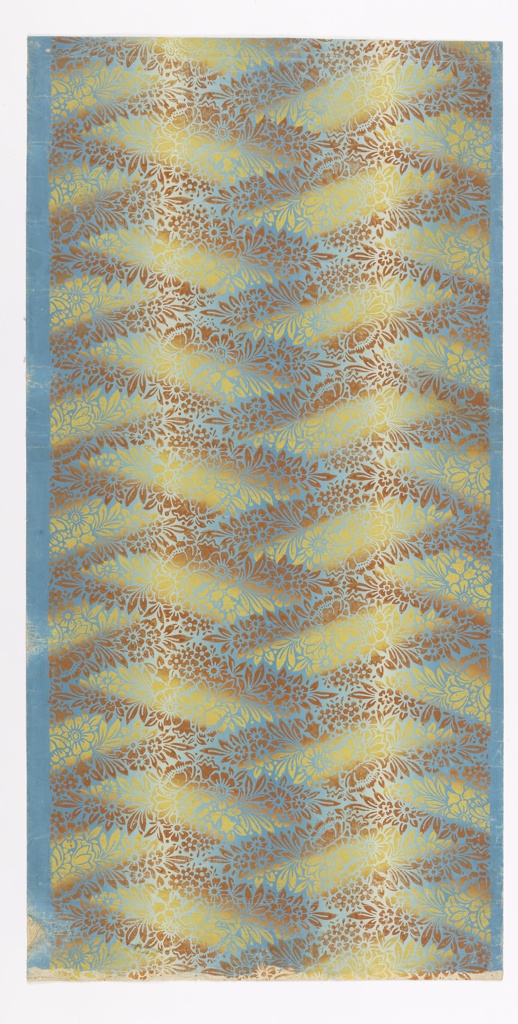There is one other image of this object. This image is in the public domain (free of copyright restrictions), and as such we offer a high-resolution image of it. See our image rights statement.
See more objects with the color silver cadetblue darkkhaki sienna darkgrey or see all the colors for this object.
Object Timeline
|
-0001 |
|
|
1955 |
|
|
1991 |
|
|
2012 |
|
|
2018 |
|
|
2025 |
|
Sidewall (Germany)
This is a Sidewall. It was manufactured by J. C. Arnold. It is dated 1820 and we acquired it in 1955. Its medium is block printed on handmade paper. It is a part of the Wallcoverings department.
A Vision of the Future
To celebrate the opening of Saturated: The Allure and Science of Color, Object of the Day this month will feature colorful objects from the exhibition.
This style of wallpaper, with its optical effect of reflecting light, is knows as an irisé, or iridescent paper. The technique, also known as rainbow method, was invented in 1819 and had a short period of popularity, until about 1830. Iris is a method of blending colors to give a subtly shaded effect. It was designed to reproduce the sheen and light reflective effects of a silk wall covering. Textile wall hangings of various kinds were the precursors of paper hangings, so it is not surprising that textiles were the earliest and most consistent influence on wallpaper design. These imitative trompe l’oeil and illusionistic effects reached their height in the early nineteenth-century.
Distemper colors were normally used for woodblock printing. To create distemper colors, organic and inorganic pigments were mixed with water and glue to produce thick-bodied, opaque, chalky colors. Many new colors were discovered and developed in the late 18th and early 19th centuries. For example, the Chrome Yellow used in this wallpaper was identified in 1797, but the formula was not published for use until 1809, and not widely available until around 1820. By the mid-nineteenth century, it was commonly used by many wallpaper makers. One way to determine the earliest possible date that a wallpaper could have been produced is through chemical analysis of the color present in the wallpaper. This particular piece consists of two ground colors, a blue and a light blue, and two print colors, chrome yellow and a reddish brown. The blending of these colors creates a mysterious beauty -- one that won’t be explained by chemical analysis.
This object is currently on view in Saturated: The Allure and Science of Color.
Kara Nichols is a graduate student in the master’s program in the History of Design & Curatorial Studies offered jointly by Cooper Hewitt, Smithsonian Design Museum and Parsons School of Design. She served as the Curatorial Capstone Fellow for the exhibition Saturated: The Allure and Science of Color.
This object was
donated by
Deutsches Tapetenmuseum.
It is credited Gift of Deutsches Tapetenmuseum.
- Sidewall, Razzmatazz
- screenprinted and flocked on machine-made paper.
- Gift of William Justema.
- 1969-70-3
- Textile (France)
- silk, metallic thread.
- Anonymous bequest in memory of Albert and Rebecca Elsberg.
- 1938-82-126-b
- Sample Blanket (USA)
- cotton, lurex.
- 1968-119-1
Our curators have highlighted 4 objects that are related to this one. Here are three of them, selected at random:
- Poster, Exhibition of Rokuro Taniuchi at Seibu Department Store
- screenprint on white wove paper.
- Gift of Sara and Marc Benda.
- 2009-12-14
- Sidewall
- block-printed paper.
- Gift of Harvey Smith.
- 1968-111-13
- Textile, Zambra
- polyester.
- 1988-111-11
Its dimensions are
H x W: 101 x 51 cm (39 3/4 x 20 1/16 in.)
Cite this object as
Sidewall (Germany); Manufactured by J. C. Arnold (Kassel, Germany); block printed on handmade paper; H x W: 101 x 51 cm (39 3/4 x 20 1/16 in.); Gift of Deutsches Tapetenmuseum; 1955-51-7
This object was previously on display as a part of the exhibitions Saturated: The Allure and Science of Color and The Cooper-Hewitt Collections: A Design Resource.






